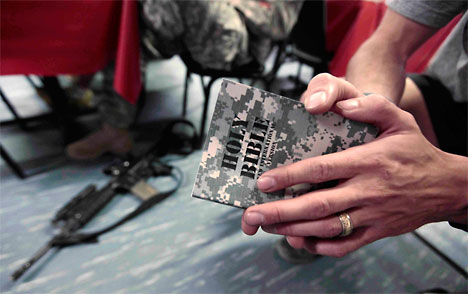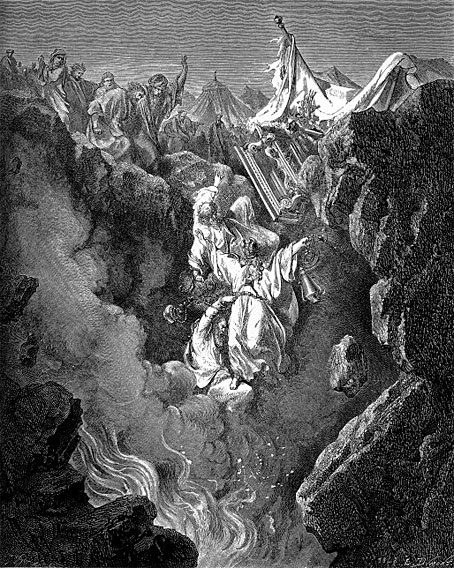Oct
7
2013

“The Spirit consistently puts earthly Succession to death, dividing families, communities and entire countries, as we see today. To claim otherwise is to work against the Spirit in the world. My heredity, my household, my culture, is the target of my ministry, not its source.”
It’s time to get back into Galatians. To recap, the epistle follows the Covenant structure, but gives the central point, the Ethics, its own Covenant structure. If this thesis is correct, what we should expect in the next “cycle” (Gal. 3:26-4:7) is a discussion of Covenant Succession. Lo and behold, this is exactly what we find.
Continue reading
2 comments | tags: Abraham, Baptism, Circumcision, Covenant Theology, Ezra, Galatians, Genesis, Isaac, Leviticus, Moses | posted in Bible Matrix, Biblical Theology
Feb
12
2013
 “With this theory of the joke in mind, the final chapter of Nehemiah is holy and hysterical.”
“With this theory of the joke in mind, the final chapter of Nehemiah is holy and hysterical.”
In his book, Deep Exegesis, Peter Leithart speaks of the biblical text as many things, but none is more confronting than his viewing the text as a “joke.” His explanation, however, makes perfect sense. What makes a joke funny? It is either prior knowledge to which not everyone is privy, or a confounding of expectations (which are also based on prior knowledge to some degree). The Bible is full of such jokes, and realizing one is in on the joke is immensely satisfying.
Continue reading
Comments Off | tags: Compromise, Ezra, Hermeneutics, Joke, Literary Structure, Nehemiah, Peter Leithart | posted in Bible Matrix, Biblical Theology, The Restoration Era
Apr
26
2012
 or A Nation of Nathans
or A Nation of Nathans
Jeremy Myers has some words to say about Gregory Boyd’s and Walter Wink’s view that political power necessarily corrupts, even demonizes, the Church:
Is There Such A Thing As A Just War?
The “Just War” theory was originally developed by Augustine to defend the Empire’s actions of arresting and killing the Donatists, with whom Augustine was having a theological disagreement. He argued that in certain situations, a war is not wrong if it furthers the cause of Christ and advances the Kingdom of God on earth.
Continue reading
2 comments | tags: Augustine, Church Discipline, Church History, Constantine, Ecclesiology, Ezra, Holy war, Nathan | posted in Biblical Theology, Quotes, The Last Days, The Restoration Era
Jan
17
2011

or The Rapture is History
“And after my skin is destroyed, this I know, that in my flesh I shall see God.” Job 19:26
Full preterism leads logically to gnosticism. If death is already defeated, salvation has come to the world, and all is now perfect, then of necessity all three — death, salvation and perfection — have to be redefined. They are only Covenantal, “spiritual.” You can probably understand why doctrines like these don’t originate from the persecuted church. Some hope.
However, that said, I agree with 97.3963798475% of full preterism. Their take on the parousia texts is logical and contextual. Jesus actually did come back soon, as He promised, to rescue the persecuted firstfruits church. The textual ping-pong of the well-meaning partial preterists (who can’t agree between themselves on which parousia texts refer to the end of history) is a confusion of which our God could not possibly be the author. So what’s the answer?
Continue reading
28 comments | tags: Against Hyperpreterism, Covenant Theology, Daniel, David, Deuteronomy, Dispensationalism, Ezekiel, Ezra, Job, Leviticus, Paul, Resurrection, Saul, Tabernacle | posted in Against Hyperpreterism, Biblical Theology, The Last Days, The Restoration Era
Jun
8
2010

“Then all the people shouted with a great shout, when they praised the LORD, because the foundation of the house of the LORD was laid. But many of the priests and Levites and heads of the fathers’ houses, old men who had seen the first temple, wept with a loud voice when the foundation of this temple was laid before their eyes.” Ezra 3:11-12
Doug Wilson writes (Less Glory Is More):
The Bible teaches us that the times of the new covenant are attended with a greater glory than the old covenant, as well as with a greater simplicity. In effect, that simplicity is part of the glory.
Continue reading
2 comments | tags: AD70, Communion, Covenant Theology, Doug Wilson, Ezekiel's Temple, Ezra, Solomon, Totus Christus | posted in Quotes, The Last Days, The Restoration Era
May
4
2010

For he is our peace, who has made us both one, and has broken down the dividing wall of hostility, by abolishing in his flesh the law of commandments and ordinances, that he might create in himself one new man in place of the two, so making peace, and might reconcile us both to God in one body through the cross, thereby bringing the hostility to an end. And he came and preached peace to you who were far off and peace to those who were near; for through him we both have access in one Spirit to the Father. (Ephesians 2:14-18)
So, the New Jerusalem—at least the way it is described in Revelation 21—is the culmination of all the “Day 6s” since the original in the Garden of Eden. And, like the walls of water at the Red Sea and Jordan crossings, this entire, miraculous arrangement is held together by the Mediator-Man, the Lamb standing at the centre.
Continue reading
Comments Off | tags: 666, AD70, Ezra, Genesis, Herod, Nehemiah, oikoumene, Revelation, Solomon, Totus Christus | posted in Biblical Theology, The Last Days, The Restoration Era, Totus Christus
Jan
28
2010

36. Acording to Preterists, all those left in Jerusalem were reckoned unholy. But see Isaiah 4:3-4.
Simple answer: Isaiah 4 refers to the “new Jerusalem” of Ezra and Nehemiah. But I’m going to use this as an opportunity to analyse Isaiah 4 and its context. This stuff blows me away.
Continue reading
Comments Off | tags: Bible Matrix, Ezra, Feasts, Isaiah, Jeremiah, Literary Structure, Nehemiah | posted in Against Hyperpreterism, Biblical Theology, The Last Days, The Restoration Era
Jun
25
2009
 “Let no one deceive you by any means; for that Day will not come unless the falling away comes first, and the man of sin is revealed, the son of perdition.” (2 Thessalonians 2:3)
“Let no one deceive you by any means; for that Day will not come unless the falling away comes first, and the man of sin is revealed, the son of perdition.” (2 Thessalonians 2:3)
Non-dispensationalists are often accused of “Replacement Theology,” that is, the church replaced Israel. But we find in the Old Testament many examples of the same process prefiguring what the people of God went through in the first century. It is not replacement, but transformation.
Continue reading
Comments Off | tags: Aaron, AD70, Caleb, Ezra, James Jordan, Judaisers, Korah, Moses | posted in Biblical Theology, Quotes, The Last Days
May
30
2009
A House of Bread
There are two kinds of whiteness in the Bible, and an understanding of this explains a great deal. There is the whiteness of covering and the whiteness of uncovering. And, as mentioned, the Bible makes a great deal out of the concept of covering.
Bone Collector
Purge me with hyssop, and I shall be clean; Wash me, and I shall be whiter than snow.
Touching a corpse made an Israelite unclean. The remains of those slain in battle were marked with lime for two reasons: so that they could be avoided by the clean, and so they could be gathered up and burned to lime by the bone collectors. Jesus said that the righteousness of the Pharisees was like a whitewashed sepulchre. Not only were they full of the ceremonial uncleanness of broken Covenant, their so-called righteousness was actually a mark from God upon them. They would be gathered to their people not by the Father sending His angels to the four corners of the Land, but by the father of lies and his scavengers sent by God to clean the wound.
This image goes right back to Genesis. Like the angels, the Covenant scavengers, though demonic, are also God’s servants. They are the raven of Noah surviving on floating corpses until the water goes down; they are the scavenging dogs that lick up Jezebel’s blood; they are the maggots in misused manna and abandoned grapes (false bread and wine); they are the unclean birds and animals that screech and howl inside the corpse of a defeated Babylon; they are worms inside Herod ‘enthroned’ as a human Gehenna.
The whiteness of the Pharisees was the whiteness of Miriam’s and Gehazi’s skin-plague. It is the whiteness of flesh and bones exposed as unclean to the eyes of God. Satan himself appeared as an angel of light, but like the Pharisees, he was a false lightbearer, a tutor guiding his children the wrong way.
Continue reading
Comments Off | tags: antichrist, Boaz, Egypt, Ezra, Herod, Jezebel, Lampstand, Laodicea, Leviticus, Manna, millstone, Pergamum, Pharaoh, Pharisees, Priesthood, Rahab, Resurrection, Revelation, Ruth, Samson, Scavengers, Solomon | posted in Biblical Theology, The Last Days, The Restoration Era
Apr
16
2009
“Because of Christ we are thought of as fools, but Christ has made you wise. We are weak and hated, but you are powerful and respected. Even today we go hungry and thirsty and don’t have anything to wear except rags. We are mistreated and don’t have a place to live. We work hard with our own hands, and when people abuse us, we wish them well. When we suffer, we are patient. When someone curses us, we answer with kind words. Until now we are thought of as nothing more than the trash and garbage of this world.” 1 Corinthians 4:10-13
So, are God’s people to wear rags? Or should they be dressed well like Solomon or the woman in Proverbs 31? Or is that even the right question?
Continue reading
Comments Off | tags: Adam, Corinthians, Daniel, Ecclesiology, Ezekiel, Ezra, Joseph, Maturity, Mordecai, Nehemiah, Noah, Paul, Proverbs, Robes, Solomon | posted in Biblical Theology, Totus Christus

































